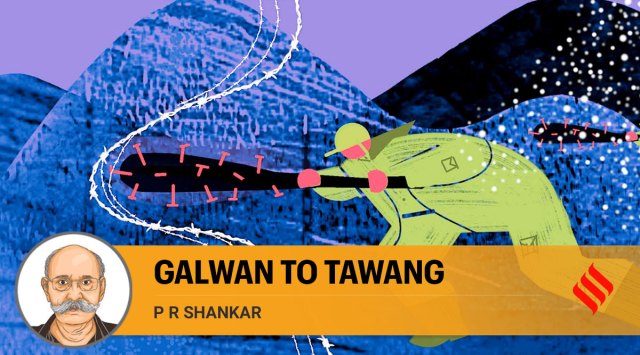
The December 9 face-off on the Line of Actual Control (LAC) in the Yangtse sub sector of Tawang is the first major violent confrontation between the Indian Army and PLA since the aggression at Galwan two years ago. Reports indicate that 200-300 PLA soldiers were trying to dislodge one LAC post held by about 50 Indian soldiers. These reports also indicate that the Indian Army retaliated strongly, helped by prompt reinforcements, and sent the PLA packing despite being outnumbered. Injuries have been sustained by soldiers of both sides, with the PLA suffering more.
Face-offs in this area occur almost annually. The last one had occurred at the same spot in October last year. However, what happened on December 9 was different in terms of the strength of the PLA forces and their intent. This was no routine patrol put out by the Chinese. As Union Minister of Defence Rajnath Singh stated, it was a blatant attempt by the PLA to change the status quo on the LAC by force.
The PLA’s attempt to seize an Indian Army post in the thick of winter, when routine troop turnover was in process, indicates a pre-planned operation to exploit a window of opportunity. The intent seems to have been to seize the post in an area claimed by the Chinese. Once seized, the post could have received reinforcements, and been made virtually impregnable during winter. The LAC would have been permanently altered. The operation would have been publicised as a victory and India would have been shown in poor light. The total consolidation of power and control over the PLA by Xi Jinping means that the Tawang incident was not the outcome of a local initiative. This operation could have only been conceived at the highest levels in China.
The LAC is a political issue in China. Politically, even a small victory over the Indian Army through salami slicing, could have diverted attention from China’s internal economic and social turmoil created by the country’s zero-Covid policy. It could have also raised the PLA’s morale and reignited the dying flames of nationalism in China — a recourse to nationalism has been a consistent theme in Xi Jinping’s policies. Capturing a post in winter from the tough Indian Army would have given China a huge geopolitical advantage, and Beijing could have claimed to have taught India a lesson. A failure, in contrast, is easily underplayed as thwarting aggression by the Indian Army into Chinese territory. Sacrifices by the PLA in defending the motherland can be extolled. That is how the Chinese narrative is unfolding.
This incident must also be viewed against a larger canvas. Is the political messaging one of retaliation against the recent Indo-US military exercises? It could also have been designed to create an emergency on the LAC that would force a postponement of the IAF exercises to be conducted in the east shortly. It is right up China’s alley to start something like this to fix India’s attention on the LAC. Such activities could enable Chinese spy ships and surveillance vessels to carry out their activity and monitor our space launch activity in the Indian Ocean Region by diverting India’s attention. It seems, therefore, that the LAC is being used as a pressure point by China as well as to send a larger international message.
The incident brings focus to another major issue. The apparent priority, as per the recent 20th Party Congress, is annexing Taiwan. However, annexing Taiwan militarily requires extensive training and resources. It is also a major political risk, given the inexperienced PLA. The chances of immediate military action against Taiwan are low. In contrast, military action along the LAC with India can be undertaken at a time and place of China’s choice, with fewer resources and calibrated for maximum effect. With exit options available, the political risks are low. Therefore, in my assessment, India is the greater priority for China from a military perspective. This is borne out by the number of incidents along the LAC in the recent past. The Tawang incident also indicates that the Chinese can be expected to strike anywhere along the LAC and we need to be prepared accordingly.
This event should force us to reflect on our security preparedness. Our jawans have displayed alertness and toughness in the high altitudes to thwart Chinese designs. The Indian Army has risen to the occasion to safeguard the territorial integrity of the nation. That is immensely reassuring. It is fortunate that the incident did not snowball or escalate into a wider conflict. Reports indicate that the Chinese are geared up for escalation in terms of firepower, resources, communications, command and control, and infrastructure — locally and in the larger strategic spectrum. Are we fully prepared for such a challenge?
Our jointness and theatrisation initiatives, launched with great fanfare, seem to be fizzling out despite the new CDS. Our modernisation programmes appear episodic. The strategic partnership plan to produce submarines has hit a roadblock. The requirement of a lightweight tank for high altitudes is still on paper. There seems to be no cogent plan for firepower enhancement. The difference between the PLA and Indian troops is evident in this incident. It should force us to rethink the ill-planned Agnipath scheme on an emergency basis. We seem to have no defence against cyberattacks or data theft through cheap mobiles as highlighted in the AIIMS case. More than the rhetoric of retaking POK, India needs to rethink national security and focus holistically on the clear and present threat — China.
The writer is a retired director general of artillery